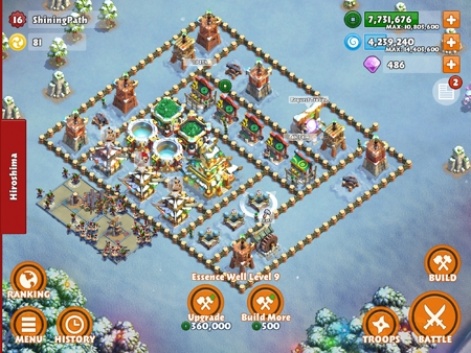2014 is a crossroads for the so-called Triple-A ("AAA") console development world, but it's a crossroads for mobile gaming too.
We're seeing behemoths forming: Supercell's massive revenues and billion-dollar buyout, King's colossal IPO, and the many other companies shaping up for a piece of the lucrative pie.
Conversely, AAA gaming is realizing it's grown too massive and unstable, and is remembering what made it - and now mobile gaming - so lucrative in the first place: the ability to be flexible and agile with smaller projects created by smaller teams.
Too big. Fail
Seemingly a AAA studio is closing down every week on the back of expectations that are sky-high. Last week, it was Irrational Games shuttering with studio head Ken Levine manning a smaller team of 15 people or so. This week there were layoffs at Sony Santa Monica.
Want an example of how silly things have gotten? Ubisoft has claimed it takes more than 400 people to make one of their open-world action games - and that was in the 360/PS3 generation.
The Xbox One and PS4 generation could swell that number higher. These larger budgets had swelled expectations out of control. Resident Evil 6 was the fourth best-selling game in Capcom history at one point, selling 5 million copies six months after release. It was considered a financial disappointment.

Do you respawn? The Last of Us
Game features have suffered from bloat too. The Last of Us has an online multiplayer mode. Has anyone talked about it at all outside of asking "Why does The Last of Us have online multiplayer?"
AAA has become so bloated that everything has to be everything. We know Bioshock Infinite made some surface changes to appeal to a mass market demographic, but that it didn't have online multiplayer is a miracle.
What's my motivation?
Even when new things get tried, they wind up being a mess. Look at Deep Down, an upcoming free-to-play PS4 game which recently sparked up a sexism controversy due to not having any playable male characters despite having procedurally-generated levels.
I don't think it's conscious evil on the team's part and just sheer incompetence.
Let's look at what makes free-to-play successful. There's availability to a wide number of people, often featuring character customization, and appeal to women, a demographic undersold by video games, also plays a large part.
In this context, Capcom's releasing a free-to-play game on a platform that has a tiny installation base, will have limited appeal to women, and limited ways for players to form an emotional connection through character customization? Are they paying attention at all?
But it's this kind of clunky approach that AAA has found itself peddling. Creativity in gameplay and business has come from new segments of the market, not the old ones.
Small light at the end of the tunnel
Yet the Irrational closure does ultimately signify a positive shift in the industry despite all the lost jobs. Levine is forming a smaller team at 2K to create a smaller 15-person team at 2K to create new digital-focused products.
And this is not an isolated event. Ubisoft saw financial success with smaller games in the Call of Juarez and Far Cry franchises as part of a "mini-AAA" business model.
Respawn Entertainment - formed after the exodus of many key Infinity Ward members following the release of Call of Duty: Modern Warfare 2 - started out with about 40 people and is at about 75 people as the hotly-anticipated Titanfall launches, which itself is fascinating because it's a multiplayer-only game, a more focused experience than the "jack-of-all-trades" era of AAA gaming.
Small is beautiful: Titanfall

Again, Double Fine has 65 employees, but they specialize in producing a diverse number of projects now after the struggles with AAA game development that they had with Brutal Legend.
They also helped spark Kickstarter as a way to fund games outside of the traditional publisher model, which they were able to do because they're independent and small enough to make shifts as needed now, instead of beholden to publishers and singular monolithic titles that could make or break them.
Flip, reverse
These AAA movements are merely reflecting why mobile and free-to-play developers have succeeded. They've shown that games don't have to be massive in scope or production values to be good or profitable - they just have to be designed well, either in quality or in monetization.
With more and open distribution platforms, it's easier to sell a game, and the tools to make a game are more widespread and powerful than ever before. The barrier to entry is so much lower now. And as AAA developers realize these benefits, they too could reap the bountiful advantages.
Conversely, my fear is that mobile's successful companies will wind up suffering the same fate as AAA: large, bloated, and unsustainable.
Given that the game generated 78 percent of its revenue in 2013, King has said that they might be seen as a one-hit wonder with Candy Crush Saga. And they have a decreasing percentage of users who pay, which could be a concern long-term.
Can anything else be as sweet? Candy Crush Saga
But all the large companies are built heavily on that free-to-play business model. And even the ones with wildly diverse product ranges are still stuck on a business model that could well be a bubble ready to pop at any point.

Research that suggests 50 percent of revenues are coming from 0.15 percent of the free-to-play population is a worrying number, especially when people have such wide selection of games to play for free.
Fresh blood
The result is the rise of the cookie-cutter.
There are the Clash of Clans clones; collectable card games as far as the eye can see; plenty of town-builders and games that use town-building mechanics; games where there's the suggestion of another genre - say, RPG battling or a fighting game, but all with automatic fighting; slot machine and casino games.
Clash of Clans or Clash of Clones?
The signs of repetition are clear, and without some fresh blood and new ideas, this stagnation could be the death blow for many mobile developers.
After all, not long ago, Zynga was the biggest player in free-to-play, but now they're spoken of in a past tense.

Thus, as 2014 shapes up to be a dramatic year of change for gaming, the two diametrically-opposed industries of AAA console development and mobile development need to look across at the other; one to exploit a strength it forgot, the other to avoid a downfall it's sleepwalking into.
Chicago-based Carter Dotson is a senior writer at 148Apps.com, which was acquired by PocketGamer.biz publisher Steel Media in 2012.





















